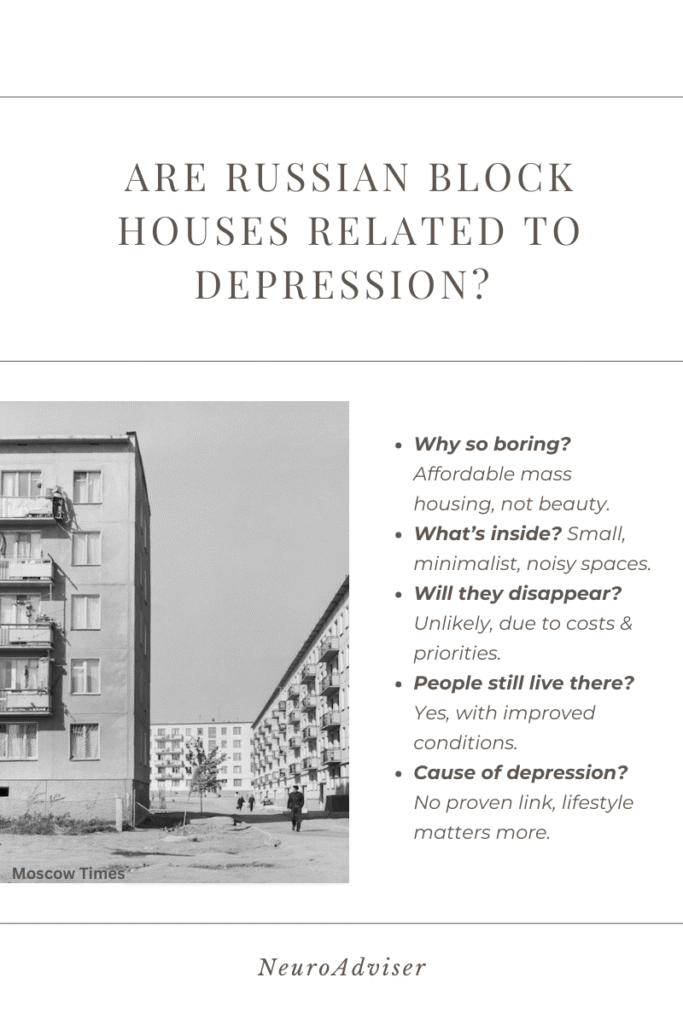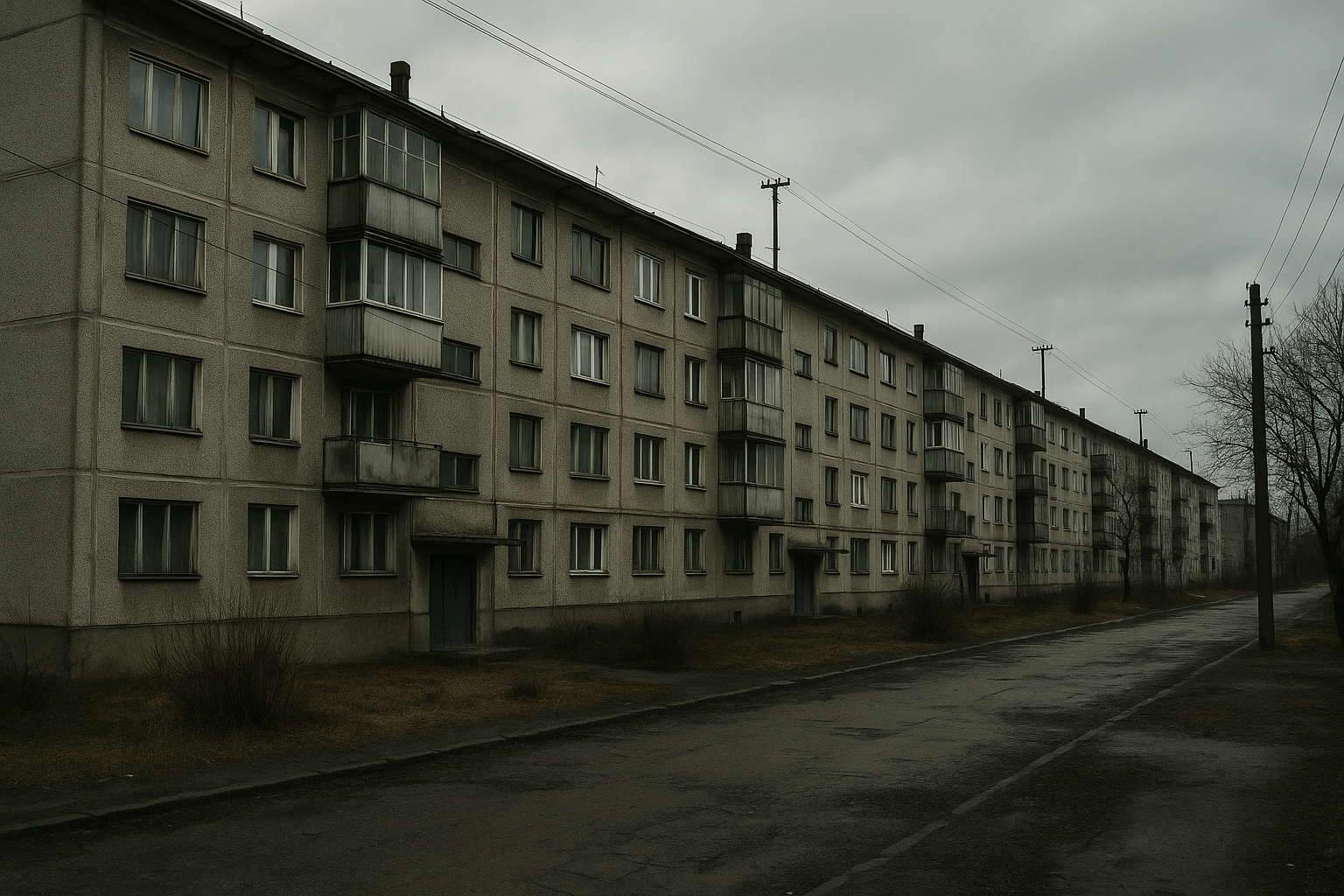Look at the image of Russian block houses of the Soviet era, you’ll get a straight impression – Lame and Boring. And there’s no doubt that bad buildings can cause mental health issues. So are Russian block houses related to depression? Yes, but indirectly!
Russian block houses, commonly referred to as Khrushchyovkas are a form of mass produced houses that were built after WWII. After the setback of war, the soviet government needed to provide shelter to nearly every citizen and the easiest way to do it is constructing block houses.
Additionally, the communist ideology of Soviet leaders prioritizes equality and collectivism over beauty. You’ll notice that almost all houses look the same because their target was uniformity rather than personal comfort.
Other Reasons Behind the Construction of Depressive Block Houses
Indeed, the housing crisis, mass-productions and soviet ideology are the main reasons behind such poorly designed buildings. However, some other reasons that cannot be ignored, are:
1. Not The Main Target
Imagine a country that’s facing major repercussions of the war – their goal would be to develop industries and military to strengthen their country. Similarly, the Soviets wanted to spend a minimum on housing to have more money saved for other important expenditures.
2. Easy To Monitor
In a country where the government controls everything, they would never support complex housing designs that make policing difficult. Instead, a shoebox like house with giant gardens, straight facades and long hallway would be much easier to survey on. Also, with no means of electronic surveillance at that time – this becomes more important.
3. Easy to Control and Maximizes Social Interaction
These block houses have massive open outdoors which make it easier to organize neighbourhood communities and rallies. Also, high occupation density discourages people from staying indoors and often spend time together in parks and other places.
4. Temporary Solution That Became Permanent
Russian block houses were built to solve the immediate housing crisis with an aim that better housing would replace them in 20-30 years. However, these are still used today due to lack of funding for large-scale urban renewal.
Inside of Russian Block Houses
The shoebox buildings already look depressing from the outside, imagine what will be inside? That’s another reason why most search for – are Russian block houses related to depression.
Basically, these houses had a compact and minimalist design with 1-3 tiny rooms combined with a bath/toilet. Thin wallpapered walls with no individual control on central heating. Also, they include space saving furniture with low ceilings that are often very noisy.
Living in such a house will surely give you depressing thoughts. Although now most houses have been renovated from the inside.
Did Russians Intentionally Design Block Housing to Cause Depression?
Obviously, no government will accept that they’re intentionally causing depression to the public. That’s why upon searching for – are Russian block houses related to depression, the main reasons that come up are WWII, housing shortage and financial constraints.
Also, when it comes to designs, humans get used to it. When you and I see the Russian block houses for the first time, we get a feeling of depression because we have a habit of seeing better buildings. However, the people living there for years get used to it and will not feel the same emotions as we do.
Moreover, the architecture inside is like paper-thin walls and tiny rooms with compromised privacy that will surely give feelings of depression. But now that most houses are renovated, the situation is much better compared to the 1950s.
Have Residents in Block Houses Reported Depression?
At present we have many unofficial chats and answers related to the topic – are Russian block houses related to depression? But no direct reports from the residents.
Even many researches have been conducted about mental health in post-soviet countries which suggests a high prevalence of mental health issues which are possibly linked to various socio-economic and historical factors, including the legacy of housing and urban planning.
However, these are broader studies and do not solely consider Russian block houses as the reason behind depression.
Future of Block Houses in Russia
Demolitions have happened at some places, especially the older houses have been replaced in some areas. However, it’s unlikely that block houses will disappear in the future. Besides, most block houses have been renovated and provide much better living conditions than before.
The economic and government policies also shape the future of these houses. When Russia is in the war again, it’s obvious that housing is not their priority. Basically, we will keep seeing block houses but the conditions inside are now better.

More On Psychology
My Teenager is Making Me Depressed! What Should I Do?
Should I Transfer Colleges If I’m Extremely Depressed? Yes or No!
Is meditation a sin in the Bible? Explained!
Conclusion
So, are Russian block houses related to depression? We have no studies proving the same, that’s why we cannot say that everyone living in those houses has depressive thoughts.
From outside the block houses look boring but it’s not a big deal for people seeing them everyday. Although, the condition from inside is a bit of concern, but now that the older homes are demolished or renovated, I don’t think they feel depressive anymore.
Hope you got the answer for – are Russian block houses related to depression? You can also post your queries in the comments.
FAQs
1. Why do Russian block houses look so dull?
It’s because these houses were built with a main focus on providing affordable homes to all after WWII. Beauty was not the goal!
2. What’s inside of the Russian block house?
Thin walls with wallpaper, low ceilings, tiny rooms and compromised privacy define block houses of the 1950s. However, most of them are now renovated.
3. Will block houses disappear in the future?
Unlikely, because of economic constraints and ongoing conflicts, housing is not the top priority of the country.
4. Do people still live in the Russian block houses today?
Yes but now the condition of these houses is much better compared to in the 1950s.
5. So are Russian block houses related to depression?
Visually and architecturally — maybe. Emotionally and mentally — not necessarily. There’s no research verifying if these houses are related to depression. Also, it’s lifestyle and socio-economic factors that primarily influence mental health, not just the buildings.
